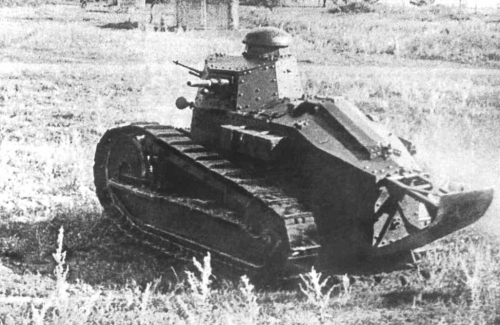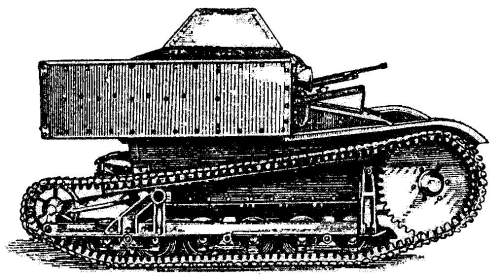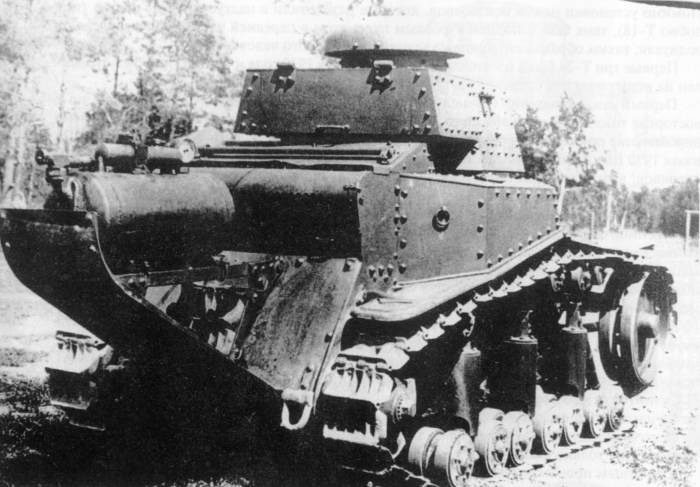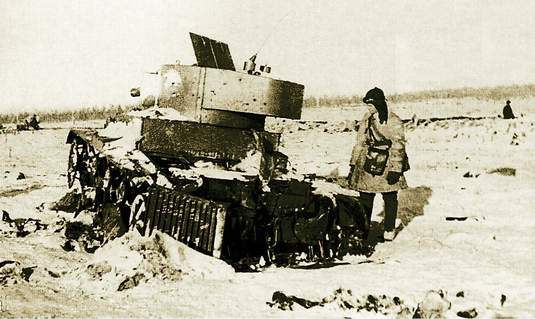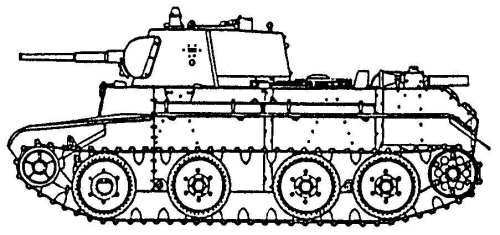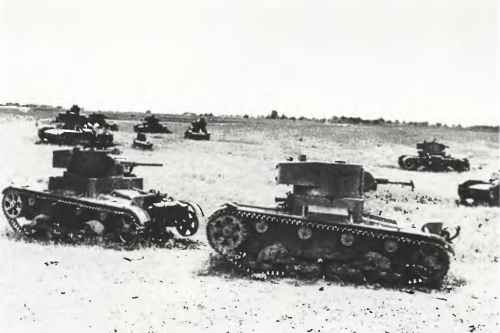Teletanks are the series (Reno-russky, T-18, TT-18, TT-27, TT-26, TT-BT-7, T-55, T-72B) of the remotely controlled unmanned robotic tanks produced in the Soviet Union in the 1920s – 1940s, 1960s, 2000s. They saw their first combat use in the Winter war – military conflict between the Soviet Union and Finland (30 November 1939 – 13 March 1940) at the start of World War II. Teletanks were controlled by radio from appropriate Control Tanks at a distance of 500-1500 meters.[1-3]
In 1927 the Central laboratory of wire communication (CLPS – local abbreviation) created the experimental radio control equipment for the tank.[4] The tests of the updated French light tank Renault FT (“Reno-russky”) with installed remote control equipment were conducted in 1929.[2]
In 1930 the tests of the T-18 tank prototype with the installed four-commands control system “Most-1” were conducted. This control system provided the tank rotation, turn on and turn off the main clutch (i.e., the motion / stop the tank). The later developed improved version of this system allowed to control the motion of three tanks simultaneously.[4]
In 1932 the pilot lot (5 pieces) of TT-27 teletankettes has been released on the basis of T-27 tankette. [2]
In 1933 the special TT-18 teletank was made (“TT” index was given only in 1934). In sum at least seven tanks of this model were released. During creation of the teletank, all authorized control equipment was removed, the new sixteen-commands control equipment (system of 1932) designed by Special technical bureau for military inventions of special purpose (Ostekhbyuro – local abbreviation) was installed on place of driver. TT-18 could change the speed and direction, stop and turn off the engine, to undermine the explosive charge on board, use the chemical devices.[2] The tests showed that the TT-18 had a good maneuverability and the ease of following commands. However, due to the low weight and relatively narrow track with high silhouette, teletank was hardly able to move along a straight line, since it is constantly diverted away on uneven terrain. [4]
The telemechanical group of tanks was developed and released at small series (55 pieces) in 1935-1936. The group consisted of TT-26 teletank – the light chemical (flame-thrower) suppression tank and the TU-26 control tank. Armament of teletank consisted of machinegun and flame thrower installation. Also sometimes it used bombs (200-700 kg) of delayed action in an armored box, which could be thrown by tank near the enemy’s fortifications. Teletanks also were adapted for the use of chemical weapons.[2]
During the 1938-1939s the works were conducted on the creation and testing of the telemechanical equipment for a group of TT-BT-7 tanks (which consisted of teletank and control tank) in NII-20 NKOP (special Scientific-research Institute of the People’s Commissariat of Defense Industry of the USSR, created after the dissolution and reorganization of Ostekhbyuro). Teletank was intended for reconnaissance of minefields, doing a passage in the barbed wire, flame-throwing, putting a smokescreen, degassing or contamination by warfare agents. The teletank’s equipment included receiver and devices of automation of control devices, arms and the servo control of friction clutches and brakes. The radiotelemechanic line was protected from the false commands and noise and provide a maximum range of up to 4000 meters. The duration of continuous control was 4-6 hours. The control of teletank could be done as directly by driver, as remotely with help of the console. Weight of control equipment did not exceed 147 kg. Hardware provided the implementation of 17 commands for control of motion, weapons and self-liquidation. At the State tests, conducted in 1940, the reliable control of the teletank from control tank was carried out at a distance of 1,000 meters. However, the aimed fire from machinegun of teletank was impossible, and the shooting to area was ineffective. [2]
The further work concerning teletanks were discontinued after the outbreak of war between Germany and USSR in 1941.
In 1963, VNII-100 (it was named as “VNIItransmash” in 1966) began the research and design works on creating the Lunokhod chassis. Also in this year the model sample of the radio-controlled vehicle was created on basis of the T-55 tank.[15]
In 2000s Moscow Institute of Electronic Technology developed (according to order of the Ministry of Defense of the Russian Federation) an experimental model of a complex for remote control of T-72B tank.
The system comprises:
– The mobile station of remote control (made on basis of the ZIL-131 vehicle) includes a Radio communication system, Workstation (AWS) of commander, AWS of gunner-operator, AWS of driver;
– A set of attachments for the T-72B tank includes a Radio communication system, Fire control system, Motion control systems, Navigation system.[20]
This complex provides the remote control of the movement and weapons of the unmanned T-72B tank at a distance of 4 km.[20]
References:
1. Teletank. – Mode of access: http://en.wikipedia.org/wiki/Teletank.
2. Телетанк. – Mode of access: http://ru.wikipedia.org/wiki/%D0%A2%D0%B5%D0%BB%D0%B5%D1%82%D0%B0%D0%BD%D0%BA.
3. Телетанк. – Mode of access: http://uk.wikipedia.org/wiki/%D0%A2%D0%B5%D0%BB%D0%B5%D1%82%D0%B0%D0%BD%D0%BA.
4. Т-18. – Mode of access: http://armor.kiev.ua/wiki/index.php?title=%D0%A2-18.
5. Русский Рено. – Mode of access: http://ru.wikipedia.org/wiki/%D0%A0%D1%83%D1%81%D1%81%D0%BA%D0%B8%D0%B9_%D0%A0%D0%B5%D0%BD%D0%BE.
6. Файл:Reno-russky during manoeuvres.jpg. – Mode of access: http://ru.wikipedia.org/wiki/%D0%A4%D0%B0%D0%B9%D0%BB:Reno-russky_during_manoeuvres.jpg.
7. Карпенко А. В. Обозрение отечественной бронетанковой техники (1905-1995) / А. В. Карпенко. — Санкт-Петербург: «Невский бастион», 1996. — 480с.
8. t18h.jpg. – Mode of access: http://armor.kiev.ua/Tanks/WWI/1sov/t18h.jpg.
9. tt_26_3s.jpg. – Mode of access: http://cft2.mobi.ru/Articles/1/283/tt_26_3s.jpg.
10. Средства связи на поле боя / Для тех, кто в танке. – Mode of access: http://mobimag.ru/Articles/283/Sredstva_svyazi_na_pole_boya.htm.
11. Что такое телетанк?. – Mode of access: http://www.odintsovo.info/news/?id=1683.
12. Информационный портал города Кубинка — Описание телетанка. – Mode of access: http://kybinka.info/index.php?option=com_content&task=view&id=26&Itemid=54.
13. Остехбюро. – Mode of access: http://ru.wikipedia.org/wiki/%D0%9E%D1%81%D1%82%D0%B5%D1%85%D0%B1%D1%8E%D1%80%D0%BE.
14. Альтаиру 75 лет // Из истории предприятия. – Mode of access: http://www.altair-navy.ru/rus/75years/.
15. Официальный сайт ОАО «ВНИИтрансмаш». – Mode of access: http://www.vniitransmash.ru/.
16. Дубинский И. В. Особый счет / И. В. Дубинский. — М.: Воениздат, 1989. — 256 с. — ISBN 5–203–00809–4.
17. Павлов М. В. Танки БТ / М. В. Павлов, И. Г. Желтов, И. В. Павлов. — М.: ООО «Издательский центр «Экспринт», 2001. — 184 с. — ISBN 5–94038–019–0.
18. Исаев А.В. Дубно 1941. Величайшее танковое сражение Второй мировой / Алексей Исаев. – М.: Яуза; Эксмо, 2009. – 192 с. – ISBN 978-5-699-32625-9.
19. Ударная сила – Лунный танк (66 выпуск). – Mode of access: http://www.youtube.com/watch?v=TODQhZ6lsm4.
20. Телетанк Т-72Б. – Mode of access: http://www.youtube.com/watch?v=3PXt9TiYwVE.
See also: Tracked mine, Lunokhod, Klin-1 Robotic complex, STR-1 Specialized transport robot.
1 This image is in the public domain.
